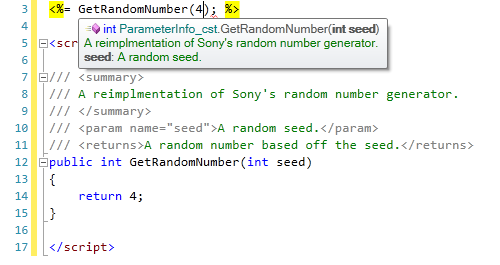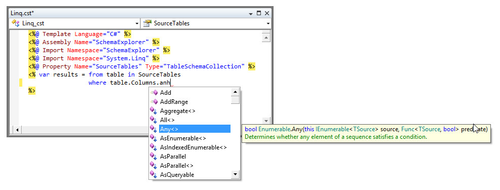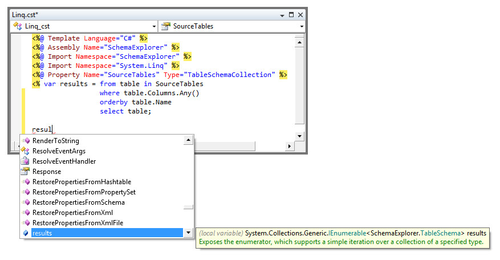Statement completion is very similar to the IntelliSense feature of Visual Studio. With Statement Completion, Template Editor prompts you with identifier names as you type.
...
Automated parameter info tips show whenever typing an invocation (E.G., a method call). The tips show detailed information about the invoked member along with details about the current argument being typed. In the case where the invoked member has multiple overloads, arrows show on the popup and allow toggling between all the available overloads.
As with quick info, parameter info can handle rich-formatted content display using HTML-like markup tags. Colors and font weights or styles can be used to bring attention to portions of the info tip. The screenshot above shows the font weights bringing attention out to the current parameter seed.
Multiple signature options can be displayed in a single parameter info tip. In those scenarios, arrows automatically appear that can be clicked. Alternatively the end user can use the up/down arrow keys to switch between options.
Anonymous Types
In previous versions of CodeSmith Generator there was no support for anonymous types or extension methods. The sample below will show off an example of Anonymous Type support.
...
In previous versions of CodeSmith Generator there was no statement completion support for LINQ query expressions. The sample below will show off statement completion for LINQ query expressions.
First, let's start typing a new LINQ query expression:
The SourceTables property shows up as a TableSchemaCollection. Now we'll start a where clause:
The table range variable is of type TableSchema. After typing a period to see the table variable's members, we see fields like Columns and Database.
Typing a period to see the Columns field's members shows how all the Enumerable extension methods get pulled in.
Now we add an orderby clause and follow it up with a select clause to end the expression.
Finally, after the first statement, we do a Ctrl+Space to bring up the statement completion and the results variable in the list shows the result type from the query expression, which is IEnumerable<TableSchema>.





